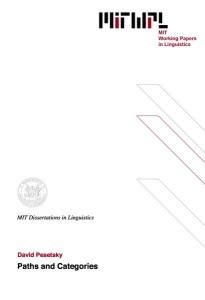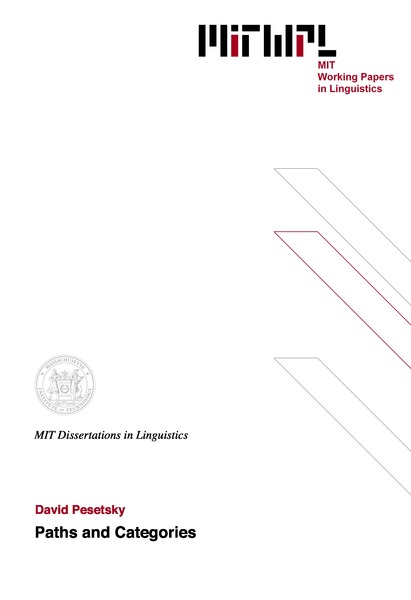Paths and Categories
D. M. Pesetsky, 1982
This study has two parts. In Part I, we consider the role of categorial selection in the theory of grammar. Categorial selection governs the category of a predicate’s arguments, determing, for example, whether an argument must be an NP, and S’, etc. We study asymmetries between subjects and objects in three quantificational constructions in Russian: the genitive of negation, distributive phrases with po, and numeral phrases. The subject/object asymmetries can be explained by Chomsky’s (1981a) Empty Category Principle (ECP), if we separate categorial selection from q-theory, which governs the assignment of thematic (q-) roles. We propose that categorial selection applies only at the level of Logical Form (LF), while q-theory applies at the three levels of D-structure, S-structure and LF. This has wide consequences for the categorial status of empty categories, which in turn allows us to explain the subject/object asymmetries. We extend our analysis to Russian Infinitival free relatives and secondary predicate constructions. Finally, after separating categorial selection from q-theory, we argue that categorial selection itself should be subsumed under a more general semantic theory.
In Part II, we turn our attention to the ECP itself. We argue that the ECP, the Subject Condition (Chomsky 1973), and well know constraints on the crossing and nesting of dependencies fall together under a general theory governing the interaction of paths in a syntactic tree. A new subsystem of grammar is proposed, Path Theory, which contains a definition of paths, based on work by Kayne (1981a, 1982), and a Path Containment Condition (PCC). We compare the PCC to other account of Crossing effects, and to the ECP, in Chapter Three.
In Chapter Four, we extend Path Theory to constructions with multiple gaps, adapting ideas of Kayne (1982). We deal first with the “parasitic gap” constructions of Taraldsen (1981), Engdahl (1981) and Chomsky (1981b). We then turn our attention to coordinate structures, arguing that most of Ross’s (1967) Coordinate Structure Constraint derives from the PCC. Applying the general theory of multiple gaps to coordinate structures, we explain immediately the possibility of “Across the Board” exceptions to Ross’s constraint, including certain subject/object asymmetries discovered by Williams (1978). We discuss constraints on the conjunction of tensed and infinitival clauses in the context of Across the Board exceptions to Ross’s constraint, and consider in this connection the status of expletive null subjects in so-called “pro-deop” languages.
In Chapter Five, we consider other topics in Path Theory. We present a PCC account of ECP and Superiority Condition effects in Wh-in-situ constructions. We discuss some distinctions between indicative and subjunctive clauses. Finally, after considering some problems that arise in Path Theory, we note some desirable implications of Path Theory for the definition of government.
Thesis supervisor: Noam Chomsky
Title: Institute Professor
Table of Contents
Part One Categories
Chapter 1 Introduction
1 UG and Core Grammar 12
2 q-theory, the Projection Principle, and Binding Theory 16
3 The Projection Principle, q-criterion, and Categorial Selection 29
Footnotes 38
Chapter 2 Russian Quantification and Categorial Selection
1.0 Three descriptive conditions 40
1.1 Genitive of negation 40
1.1.1 The D-structure [XP, VP] restriction 41
1.1.2 The non-obliqueness restriction 64
1.1.3 Obligatory quantifier movement 65
1.2 Po-phrases 69
1.2.1 Po-phrases and the D-structure [XP, VP] restriction 70
1.2.2 Po-phrases and the non-obliqueness restriction 72
1.2.3 Po-phrases and obligatory QR 73
1.3 No-agreement numeral phrases 74
1.3.1 No-agreement numeral phrases and the D-structure
[XP, VP] restriction 77
1.3.2 No-agreement numeral phrases and the
non-obliqueness restriction 79
1.3.3 No-agreement numeral phrases and obligatory QR 82
2.0 The non-obliqueness restriction and the QP hypothesis 86
2.1 The QP hypothesis
2.2 Oblique vs. structural case
2.3 The non-obliqueness restriction
3.0 QP’s and the Empty Category Principle
4.0 The ECP, Category Blindness and Conditions A and C 122
4.1 QP and the ECP
4.2 Categorial selection and condition C 129
4.3 Categorial selection and condition A 134
4.4 Two more cases 149
4.4.1 Infinitival free relatives 149
4.4.2 Secondary predicates 150
4.4.2.1 Secondary predicates and the D-structure
[XP, VP] restriction 165
4.4.2.2 Secondary predicates and the
non-obliqueness restriction 169
4.4.2.3 Secondary predicates and small clauses 170
5.0 Categorial and semantic selection 180
Footnotes 206
Part Two Paths
Chapter 3 Crossing Effects, the ECP, and the Subject Condition
0 Introduction 248
1.0 The structure of S 250
1.1 The definition of subject 255
1.2 Contraction 255
2.0 Remarks on the ECP 264
3.0 Crossing and nesting 267
3.1 Crossing effects 267
3.2 Complementizer-trace phenomena 272
4.0 Crossing dependencies vs. paths 277
4.1 Crossing in two dimensions 277
4.2 Paths 288
4.3 Paths vs. linear crossing 297
4.4 CTP effects 305
4.5 The subject condition 313
4.6 The subject condition in small clauses and s’-deletion
infinitivals 319
4.7 Conclusions 337
Footnotes 339
Chapter 3 Multiple Gaps and Paths
1.0 Introduction 356
2.0 Paths and parasitic gaps 357
2.1 Parasitic gaps and subject condition violations 357
2.2 Parasitic gaps and “connectedness” 368
2.3 Left branch extraction 387
2.4 Russian QPs revisited 406
2.5 Parasitic gaps and crossing effects 420
3.0 Coordination and multiple gaps 433
3.1 The Coordinate Structure Constraint 433
3.2 Across the Board 443
3.3 The path between INFL and COMP 459
Appendix to 3.3 484
4.0 Multiple gaps, the PCC, and subjacency 488
4.1 A unified theory of multiple gap constructions 490
4.2 Chomsky’s analysis of parasitic gaps 498
4.3 Subjacency and the PCC 505
4.4 The PCC and LF, counteranalyses of ATB phenomena 511
4.5 Move-a, subjacency, and the PCC 530
5.0 Conclusions 551
Appendix: slash categoires and coordination 554
Footnotes 559
Chapter 5 Further PCC Effects
1.0 Introduction 585
2.0 Infinite paths: wh-in-situ and gapping 586
2.1 Wh-in-situ 586
2.2 ECP, Superiority, and the PCC 595
2.2.1 Pure ECP effects 595
2.2.2 ECP/Superiority effects 598
2.2.3 Pure superiority effects 602
2.2.4 Infinite paths and wh-in-situ 605
2.3 Multiple wh-in-situ and absorption as coindexation 613
2.4 Wh-in-situ and Logical Form 629
2.5 Focus and gapping 640
2.5.1 Focus and the PCC 640
2.5.2 Gapping 642
3.0 Subjunctives and W-verbs 659
4.0 Problems for the PCC 682
4.1 The PCC and QR 683
4.2 The PCC and Preposition Stranding 687
4.3 The PCC and NP-trace 690
5.0 Path Theory and the PCC 694
5.1 Path Theory and the definitions of government 695
5.2 Conclusions 702
Footnotes 705

